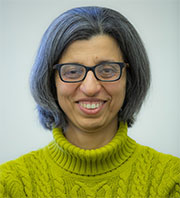 Dr. Namrata Vaswani is the Anderlik Professor of Electrical and Computer Engineering at Iowa State University. She received a Ph.D. in 2004 from the University of Maryland, College Park, and a B.Tech. from the Indian Institute of Technology (IIT-Delhi) in India in 1999. Her research interests lie in data science, with a particular focus on statistical Machine Learning, Statistical Signal Processing, and Computer Vision. She has served two terms as an Associate Editor for the IEEE Transactions on Signal Processing; as a lead guest-editor for a Proceedings of the IEEE Special Issue (on Rethinking PCA for modern datasets); and is currently serving as an Area Editor for the IEEE Signal Processing Magazine. Vaswani is a recipient of the Iowa State University Mid-Career Achievement in Research Award (2019); the University of Maryland’s ECE Distinguished Alumni Award (2019); the Iowa State Early Career Engineering Faculty Research Award (2014); and the IEEE Signal Processing Society Best Paper Award (2014) for her IEEE Transactions on Signal Processing paper on “Modified-CS: Modifying Compressive Sensing for Problems with Partially Known Support” co-authored with her graduate student Lu. Vaswani is a Fellow of the IEEE (class of 2019) for contributions to dynamic structured high-dimensional data recovery.
Dr. Namrata Vaswani is the Anderlik Professor of Electrical and Computer Engineering at Iowa State University. She received a Ph.D. in 2004 from the University of Maryland, College Park, and a B.Tech. from the Indian Institute of Technology (IIT-Delhi) in India in 1999. Her research interests lie in data science, with a particular focus on statistical Machine Learning, Statistical Signal Processing, and Computer Vision. She has served two terms as an Associate Editor for the IEEE Transactions on Signal Processing; as a lead guest-editor for a Proceedings of the IEEE Special Issue (on Rethinking PCA for modern datasets); and is currently serving as an Area Editor for the IEEE Signal Processing Magazine. Vaswani is a recipient of the Iowa State University Mid-Career Achievement in Research Award (2019); the University of Maryland’s ECE Distinguished Alumni Award (2019); the Iowa State Early Career Engineering Faculty Research Award (2014); and the IEEE Signal Processing Society Best Paper Award (2014) for her IEEE Transactions on Signal Processing paper on “Modified-CS: Modifying Compressive Sensing for Problems with Partially Known Support” co-authored with her graduate student Lu. Vaswani is a Fellow of the IEEE (class of 2019) for contributions to dynamic structured high-dimensional data recovery.
We approached her with a few questions.
Q. Why did you become a professor at Iowa State University?
I grew up in Delhi in India in the 1980s and early 1990s before the internet reached India. I was fortunate to grow up in a household where education was greatly prioritized. My mother herself is a retired professor with a Ph.D. in Chemistry, while my aunt (who was like a second mother) never going to go to college and regretted it always. At the time in India, the two most popular career choices for anyone who wanted a career were “doctor” and “engineer”. Girls were pushed more towards medicine than engineering. My choice was part rebelling against the norm and part of the fact that I realized in middle school that Math was my favorite subject. I also realized later that Physics fascinated me so Electrical Engineering was something I hoped to pursue. But then the final decision was made not by me, but by the IIT Joint Entrance Exam rank, and luckily for me it worked out and I ended up in the EE B.Tech program at IIT-Delhi. In my third semester, Prof. SD Joshi taught the first Signals and Systems course and that was one of the most fascinating courses I had taken in my three semesters. I have to admit I didn’t follow everything or at least truly understand all the implications until much later. But that is what got me interested in signal processing first. That, along with a later statistics course and some communications courses, where I learned more probability, was what has shaped my research interests. After my undergrad, I went to the University of Maryland, College Park, for a Ph.D. Even when starting my program, academia wasn’t the plan. It was Rama (Prof Rama Chellappa) at Maryland who pushed me to apply for postdocs and then faculty positions and I am so glad he did (and, for once, I listened!). I do not think I would have been enjoyed any other job and may have eventually switched to academia. It is the only job that allows you to literally do what you want when you want: you can switch areas, spend time learning about a topic, every time I teach even an undergraduate course I learn something new myself!
Q. How does your work affect society?
Truly speaking, it doesn’t (or at least not very directly) except of course for the education I provide: both to undergraduate and graduate students through my classroom teaching and to others through tutorials or other research-based lectures I have given; and all the notes and slides and videos posted online. In this sense, as Athina mentions, I have helped train future engineers to think critically, as well as graduated multiple Ph.D. students who are now at Google, Bosch, Adobe, AT&T, KLA-Tencor, or at research labs.
My research is best described as algorithms and theory for statistical machine learning and signal processing problems inspired by imaging applications (medical imaging, computer vision, and video analytics in particular). Each of my methods has the potential to change the state-of-the-art “in principle” as I explain next. I have done extensive work on the design and analysis of online and mini-batch algorithms for solving various dynamic (time-varying) structured high-dimensional data recovery problems such as dynamic compressive sensing (CS), dynamic robust PCA, and low-rank phase retrieval and subspace tracking. Online and mini-batch algorithms are needed for real-time applications, and even for offline applications, they are typically faster and need less storage compared to batch techniques. Most importantly, my work shows that such algorithms provide a natural way to exploit temporal dependencies in a dataset without increasing algorithm complexity (speed or memory); and that exploiting such dynamics provably results in either reduced sample complexity or improved outlier tolerance, or both. The former implies proportionally reduced acquisition time for applications such as MRI where data is acquired one sample at a time. The latter implies increased robustness to difficult outliers such as persistent foreground occlusions in videos.
To provide more details, dynamic CS solutions can enable real-time dynamic MR Imaging. These exploits the Spatio-temporal correlation inherent in medical image sequences to greatly reduces the number of Fourier domain samples needed to obtain an accurate reconstruction of all images except the first one. Dynamic robust PCA based solutions provide the critical first step for dynamic computer vision and video analytics in uncontrolled environments (those with changing backgrounds) by making it easy to decompose a video into its foreground and background layers.
Q. What challenges you had to face to get where you are today?
Research is always challenging and so is picking interesting problems to work on. Besides all the usual research challenges and some personal health challenges, things have not been too hard until now. Or maybe, given the current challenges I cannot even recall any time in the past that was too difficult! On the personal front, my husband is more than a true co-parent for our daughter who’s 7 now. He’s a professor too and in a similar, but not the same, area which makes for interesting dinner table conversations! My daughter is an easy kid most of the time and has always liked going to daycare, school, or camp, making life very low stress.
However, the pandemic has changed things a lot. In the first two months, it took some adjustment but I was able to manage to finish out my Spring teaching, and complete pending research tasks such as getting our half-done pieces of work done and submitted. However, once that was done in early June, it’s been impossibly hard to focus on exploring new areas, finding interesting problems to work on, all while staying home, having student meetings remotely, and having a child at home! Of course, I should say, I am fortunate to have a research program that does not “require” any in-person interactions and I have the option to also teach remotely in the Fall. In this sense, things are as good as can be “in theory”; but still trying to start new project(s) during this period has by far been the biggest challenge I’ve faced in my career so far.
Q. What advice would you give to scientists/engineers in signal processing?
For girls and women: with very high probability, you are way smarter and better at what you do than you think! So, do not underestimate yourself.
For everyone: Be honest and careful in what you do and how you present it in a written document so that (i) your writing correctly describes what you really did; and/or (ii) your proofs of theoretical results are indeed proofs (meaning that each step is a clear and logical consequence of the previous without any uncertainty). This is equally important in both industry and academia: do not use the data to tell you what you or your boss “feel like believing” but instead what it indeed is telling you -- and that may sometimes be “nothing is conclusive”.

 Dr. Namrata Vaswani is the Anderlik Professor of Electrical and Computer Engineering at Iowa State University. She received a Ph.D. in 2004 from the University of Maryland, College Park, and a B.Tech. from the Indian Institute of Technology (IIT-Delhi) in India in 1999. Her research interests lie in data science, with a particular focus on statistical Machine Learning, Statistical Signal Processing, and Computer Vision. She has served two terms as an Associate Editor for the IEEE Transactions on Signal Processing; as a lead guest-editor for a Proceedings of the IEEE Special Issue (on Rethinking PCA for modern datasets); and is currently serving as an Area Editor for the IEEE Signal Processing Magazine. Vaswani is a recipient of the Iowa State University Mid-Career Achievement in Research Award (2019); the University of Maryland’s ECE Distinguished Alumni Award (2019); the Iowa State Early Career Engineering Faculty Research Award (2014); and the IEEE Signal Processing Society Best Paper Award (2014) for her IEEE Transactions on Signal Processing paper on “Modified-CS: Modifying Compressive Sensing for Problems with Partially Known Support” co-authored with her graduate student Lu. Vaswani is a Fellow of the IEEE (class of 2019) for contributions to dynamic structured high-dimensional data recovery.
Dr. Namrata Vaswani is the Anderlik Professor of Electrical and Computer Engineering at Iowa State University. She received a Ph.D. in 2004 from the University of Maryland, College Park, and a B.Tech. from the Indian Institute of Technology (IIT-Delhi) in India in 1999. Her research interests lie in data science, with a particular focus on statistical Machine Learning, Statistical Signal Processing, and Computer Vision. She has served two terms as an Associate Editor for the IEEE Transactions on Signal Processing; as a lead guest-editor for a Proceedings of the IEEE Special Issue (on Rethinking PCA for modern datasets); and is currently serving as an Area Editor for the IEEE Signal Processing Magazine. Vaswani is a recipient of the Iowa State University Mid-Career Achievement in Research Award (2019); the University of Maryland’s ECE Distinguished Alumni Award (2019); the Iowa State Early Career Engineering Faculty Research Award (2014); and the IEEE Signal Processing Society Best Paper Award (2014) for her IEEE Transactions on Signal Processing paper on “Modified-CS: Modifying Compressive Sensing for Problems with Partially Known Support” co-authored with her graduate student Lu. Vaswani is a Fellow of the IEEE (class of 2019) for contributions to dynamic structured high-dimensional data recovery.
